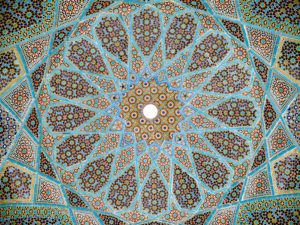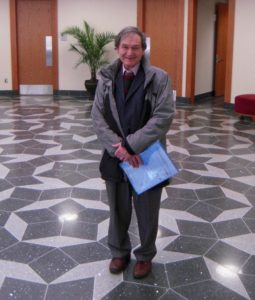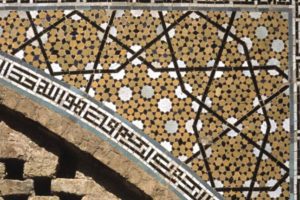
The glazed ceramic decoration, on the ceiling of the Tomb of the poet Hafez in Shiraz, Iran, combines periodic and non-periodic tiling. Photo by Pentocelo; Wikimedia Commons.
This year’s Nobel Prize in physics was awarded to Roger Penrose, Andrea Ghez and Reinhard Genzel for their research on black holes. Dr. Penrose, a mathematician, proved the existence of black holes from Einstein’s theory of relativity; Dr. Ghez and Dr. Genzel spent decades gathering evidence of a black hole in our own galaxy.
Dr. Penrose also discovered “non-periodic tiling” in 1974, known as Penrose tiling. Think of your kitchen floor: It is completely covered by a repeating pattern of tiles. One simple arrangement is a set of identical square tiles, placed side by side. You can do the same with a set of triangles or a set of hexagons. However, if you try it with a set of identical pentagons, a problem arises. The pentagons will not fit snugly next to each other – in contrast to squares, triangles or hexagons.

Roger Penrose in the foyer of the Mitchell Institute Building at Texas A&M University, 2010. Photo by Solarflare100; Wikimedia Commons.
Dr. Penrose was able to formulate a tiling formation, in which a number of basic tile shapes are used to fully cover a flat surface, such that the resulting tiling pattern does not actually repeat. However, if you were to take a floor covered with Penrose tiling, you could rotate it in multiples of 72 degrees, clockwise or counterclockwise, and obtain the same pattern – an example of five-fold symmetry.
The foyer of Texas A&M University’s Mitchell Institute is covered with Penrose tiling.
The tiling stood as a unique mathematical breakthrough – until 2005, when Harvard graduate student Peter Lu discovered variations of the same non-periodic tiling patterns on a 17th-century madrassah in Uzbekistan. With his keen mathematical eye, Dr. Lu was able to distinguish between this unique non-periodic tiling, and the equally breathtaking periodic tiling patterns found in Islamic architecture and artwork throughout history. In the latter, simple circles and squares were transformed into stars and overlapping lattices to form intricate symmetric patterns. The 13th century Alhambra Palace in Granada, Spain, provides many beautiful examples of these geometric lattices.
Upon further investigation, Dr. Lu and Paul Steinhardt of Princeton University discovered further examples of non-periodic tiling dating from the 10th to the 15th century, in varied locations such as Iraq, Iran, Turkey, Afghanistan, India and Uzbekistan. They were astounded to find a near-perfect example of Penrose tiling on the façade of the 15th century Darb-I Imam shrine in Iran, created five centuries before Dr. Penrose’s discovery. They also found that a set of five basic tile shapes, called “girih” tiles, were used by craftsmen to create these exquisite patterns.
While it is not known exactly how artisans created these patterns on site, the 15th-century Topkapi scroll (housed in the Topkapi Palace in Istanbul) provides a template of 114 different patterns of girih tiles. The patterns crafted by the artisans are not the actual tiles, but outlines thereof, thus giving the impression of an intricate latticework (or “girih,” which means “knot”). These Islamic non-periodic tiling patterns also have five-fold symmetry.
What is unknown is how these Muslim artisans and mathematicians discovered girih tiles and their alignment. These unique patterns are also found in naturally occurring quasicrystals, a form of matter with atom patterns that don’t repeat, like normal crystals.
What is known is that the “Golden Age” of Islam flourished from about the 8th century to the 14th, during which time Muslim scientists made advancements in the fields of algebra, geometry, calculus, chemistry, biology, medicine and astronomy. It began with the Abbasid caliphate, which built Baghdad from scratch as its capital, located strategically along many trade routes. The caliphs put a premium on the pursuit of knowledge. They established the House of Wisdom in Baghdad where scholars of different faiths collaborated. They also undertook a massive effort to translate Greek scholarship into Arabic, which was disseminated widely.
Scholars built on this information to forge new advances. The Istanbul Museum of the History of Science and Technology in Islam provides a comprehensive look of that era.
What stands out is an era where faith, science and reason worked in harmony. Unlike the Western approach, where science and faith are deemed irreconcilable, the history of Islam is replete with the opposite.
The first verses revealed in the Koran included the command “Read,” reflections of our humble origins (“created from a clot”) and a reminder that God teaches individuals “what they knew not.” Islam’s holy book contains exhortations to study the natural world as a means to know God and a means of worship. Scientists of other faiths, such as Isaac Newton, Gregor Mendel and Thomas Bayes, have charted a similar path.
Whether it is the intricate pattern on a leaf, the sonar system of bats, or the fabric of the universe – all reflect the signs of a Creator within the Islamic paradigm. The key is that knowledge should lead to humility.
Which brings us back to the girih tiles. However they were discovered, it is no surprise that art and mathematics combined to adorn Islamic houses of worship, given that in Islam, the pursuit of knowledge is in harmony with spirituality.
Reprinted by permission of the author.








